There is nothing in the world quite like Jerry Biagini’s greeting to me when I visited him about two weeks ago. Me: “Mr. Biagini, how are you?” Jerry: “I’m 90 years old and cranky!” As it turned out, he wasn’t so cranky as all that. We spent a good four hours talking fencing history and it was entertaining, enlightening and just an all around pleasant afternoon.
If you don’t know his history, let me do a quick run-down. He started fencing in San Francisco in the late-1930s at the Unione Sportiva Italiana under Edward Visconti. He went to college in San Francisco, was an All-American, taking 2nd at the 1951 NCAA Men’s Foil championship and was named to the US National Foil squad for the 1958 World Championships in Philadelphia where he made the semi-finals and finished 12th. A five-time National medalist in Sabre team, his Pannonia squad won the title twice. He also won multiple Pacific Coast championships in all three weapons and started the San Francisco High School fencing league, ran it for decades, and it still continues to this day.
And in 1965, he and some friends gave a fencing demonstration to the Masons at the Argonne Lodge in San Francisco. Jack Baker was the front man and did the talking, it seems. He was, at this time, the Vice President of the AFLA (now USA Fencing) and was likely the organizer of the event. The participants included all those listed on the handbill above, with the addition of Iris Lucero who, for some unknown reason, didn’t make the program listing. That said, it was quite a line-up. Along with Jack and Jerry, there was Olympic Gold Medalist Dan Magay and Harriet King, a multi-time (for both) Olympian and US National Women’s Foil champion. So the Masons got their money’s worth.
Jack Baker explains the intricacies of the epee while Harriet, Alice, Dan and Jerry look on. I tried to find a record of the Argonne Lodge of the Masons in San Francisco, but they seem to have disappeared after the 1970s. Founded by veterans of the WW1 battle of the Argonne, it may have been folded into another Masonic group in San Francisco or just ran out of members. There are still several Lodges in the city today, but this one is no longer mentioned as being among them.
The event seemed to have been well attended by the Masons, and appreciated. Their newsletters, several of which are preserved in the pages of a scrapbook of Jack Baker’s that Jerry, the now-owner, allowed me to borrow and scan (the images today are all from that scrapbook), have articles both before and after the event extolling the most excellent demonstration put on by the visiting fencers. And they served cake after the demonstration, so everyone came out a winner.
The fencers actually got two cakes! One a “Welcome” cake and the other with their names inscribed in frosting. Iris, again, didn’t make the list of participants, but Ferenc Marki did.
The crowd at the Mason’s Lodge enjoys watching Maestro Ferenc Marki put Jack Baker through his paces in sabre. Now why Jack was getting the sabre lesson demo over Olympic Gold Medalist Dan Magay, who can be seen sitting watching, his head just under Jack’s chin, is a mystery. Maybe Jack was a Mason and wanted to be in the spotlight. While he was a solid fencer and member of a couple of Pannonia’s National Champion sabre teams, one of the greatest sabre fencers of the late-50s, early-60s has been left on the bench. If this was my fantasy fencing team, I’d have made a switch here before game time.
The best thing about this scrapbook, however, is not the Masonic demo, but rather the information it contains about Jerry Biagini’s fencing career. Jerry and Jack were close friends and Jack obviously took pains to preserve some photos and other items he had that spelled out details about Jerry’s fencing career.
The above is a photograph, presumably taken by Jack Baker, of Jerry Biagini’s All-American certificate for his performance at the 1951 NCAA Championships. Jerry took second at this event and it was the only year he competed at collegiate nationals. He finished behind Bob Nielsen of Columbia and ahead of 3-time Olympian Hal Goldsmith of CCNY. Shout out to George Masin for the excellent documentation he is doing on the complete history of the results from the NCAA fencing championships.
Jerry de-planing after his return flight from Illinois after the NCAA’s. From my childhood, I remember the Western Airlines jingle very well. “Western Airlines…. the ooooooonly way to fly!” Of course it’s the animated commercials I remember. You can watch them on YouTube!
Jerry’s fencing master, as I mentioned above, was Edward Visconti. Visconti retired as a coach when Jerry was still a very young fencer. He helped Hans Halberstadt by providing him with the seed equipment to open the Halberstadt Fencers Club in 1941 after his own club was shuttered by the government due to concerns about Italian fascists infiltrating or influencing the club members. Jerry didn’t pick up another coach. He went without regular coaching until a new player arrived on the scene. The final stop on the cross-country tour undertaken by members of the Hungarian Olympic team in 1956 to raise money for Hungarian refugees, who were welcomed with open arms by the US, was in San Francisco. (More here.) At the event, Jerry and Visconti were introduced together to the great George Piller. Visconti didn’t have any Hungarian and Piller’s Italian wasn’t great, but they got by speaking in a mix of French and Italian. Visconti and Piller were both WW1 veterans – Visconti came to the US shortly after that war – both were decorated veterans, both had trained at Military Academies. Immediate friendship, mutual respect. Visconti asked Piller, “Maestro, will you please teach my student?” Piller replied, “If I remain in San Francisco, I would be honored.” Well, stay he did and coach Biagini he did, too.
A photographed copy of the letter Jerry received informing him of his selection to the US Men’s Foil team for the 1958 World Championships held in Philadelphia. Note the date of the letter, July 15, for the event a month later and oh, by the way, we’re not paying any of your expenses. Travel, housing, equipment, everything was coming out of the pockets of the participants. Ralph Goldstein would inform Jerry of how to train and won’t you please write him back to say if you’re coming? Think things have changed much for US fencers representing the US on the international stage? Maybe just a little, huh?
Since I have it, below is a three minute clip of film footage taken by Torao Mori at the 1958 World Championships. They were held at the University of Pennsylvania in the Hutchinson Gymnasium and while there isn’t any fencing in the clip, it does show an overview of the venue and near the end a shot of the large scoreboard for the 8-man Men’s Foil finals that included Albie Axelrod, still two years shy of his Bronze Medal performance at the 1960 Olympic Games.
No sound on the clip above. Jerry Biagini and the other American fencers performances are spelled out in the two news clippings below:
In the first round, all the US fencers advance. Pool A: Axelrod, Pool B: Hal Goldsmith, Pool C: Gene Glazer (mis-labeled as representing SUA instead of USA), Pool D: Biagini after a 3-way fence off, Pool E: Ed Richards. In round two, Glazer and Goldsmith are eliminated and Axelrod, Richards and Biagini advance, with Biagini once again in a 3-way fence off. Here’s an odd thing, though. The first round has pools of 6 & 7. Axelrod is in a pool of 7, but one fencer is scratched, so 5 bouts. In the second round, there’s still a pool of 7. This is arranged because the fencers with a first-round free pass (in fencing parlance, a ‘bye’) have now entered the field, so they still had an odd number to divide. But pool D and pool E, both pools of 6, don’t finish all their bouts, my assumption being that the last bouts wouldn’t figure in who was or wasn’t advancing. Albie advances after a fence-off, so he’s now fenced 12 bouts. Jerry, with fence-offs in each of his first two pools, has fenced 13 bouts. Five of six fencers with first round byes have only fenced 4 bouts and the rest 5 or 6. Ed Richards, advancing without any fence-offs, has 10 bouts under his belt. It pays to get those byes.
In the quarter-finals, Axelrod goes undefeated. Counting his fence-off bouts, his overall record is 14-3 going into the semi-finals. Ed Richards goes 2-3 and has a fence-off where he loses to Baudoux of France and goes out. Biagini again has a 2-way fence-off with a 2-3 record and splits the fence-off, 1-1, and advances. Jerry’s overall now stands at 10-10 and he’s fenced twice as many bouts as every other fencer he’s going to face in the semi-finals. Where he goes down with no victories and 4 defeats. His last match against the Hungarian Gyuricza, the 1954 World Champ, isn’t fenced as the results are already determined. Axelrod toughs out a 2-3 pool record and has to beat Kamuti and Fulop, two tough Hungarian bouts, in a fence-off. So going into the final, Axelrod is 17-6 overall, 23 bouts, compared to almost all of the other finalists having fenced 15. Biagini and Axelrod were the only fencers to get into the semi-finals that didn’t start the day with a bye in the first round. Axelrod finishes in 5th place, Biagini 12th. What could Albie have done if he’d fenced 8 fewer bouts going into the final? As it was, he still defeated the eventual winner, Bergamini, 5-1, the only loss in the final for the champion. Axelrod, at 20 wins, 10 losses, has an overall winning percentage of 66%. Bergamini’s record of 15 wins, 6 losses on the day, gives him a 71% winning percentage. The 2nd & 3rd place finishers both had overall winning percentages of 64%. Fun with numbers! Draw your own conclusions!
Jerry got a little bit of a reprise later in 1958 when the Italian teams made a trip across the US and stopped in San Francisco for an exhibition match held at the Fairmont Hotel. (See here for more details on that fabulous evening of entertainment.) Above, Biagini on the right is up against his World Championship semi-final opponent Edouardo Mangiarotti. They both went out in that round. I have in the Archive all the extant negatives shot that night by John McDougall. This is one of John’s photos, but, sadly, this negative didn’t survive to come my way. Somehow, and most fortunately, Jack Baker seems to have taken a photo of a print of this image and it’s in his scrapbook.
As a one-last-thing to mention, there’s one other little tid-bit that was in the scrapbook that I have to include. This is from an earlier date than most of the above-mentioned history, but in my mind, it’s saving the best for last. And how Jack Baker got a photograph of this document, I can’t guess. I don’t know if Jerry still has the original, or not. I will ask him when I return the borrowed scrapbook, now that I’ve got it scanned. The interesting thing about all these documents above that I scanned from the scrapbook, they all are photographic prints. My brother the professional photographer thought they looked like contact prints, so they would have been shot with a large format camera of some type, or maybe Jack was a home-photographer and made enlargements on photo paper from his own negatives. I don’t know. Obviously. But he did take a picture of the following letter, dated July 10, 1949, just a few weeks after that year’s US National Fencing Championships. I’ll allow Aldo Nadi to have the last word today as he relays some interesting opinions from Giorgio Santelli. Cheers!



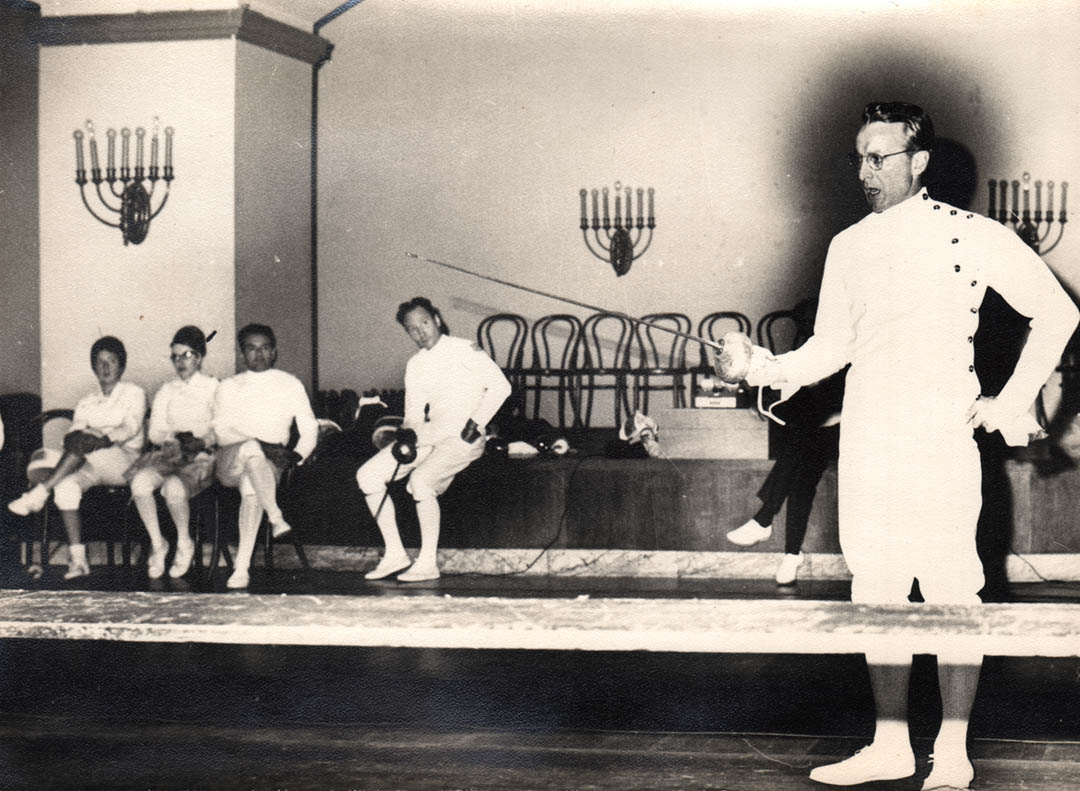
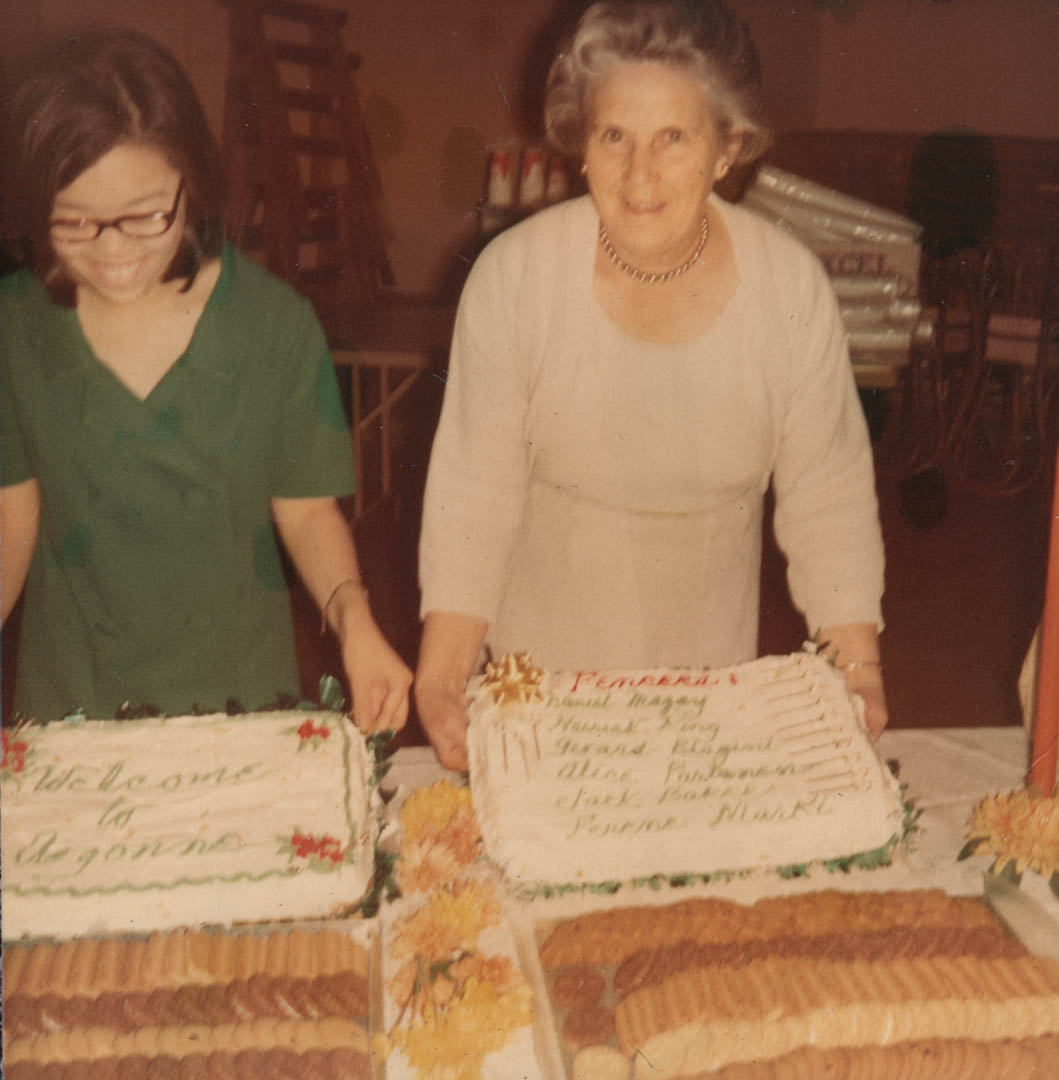
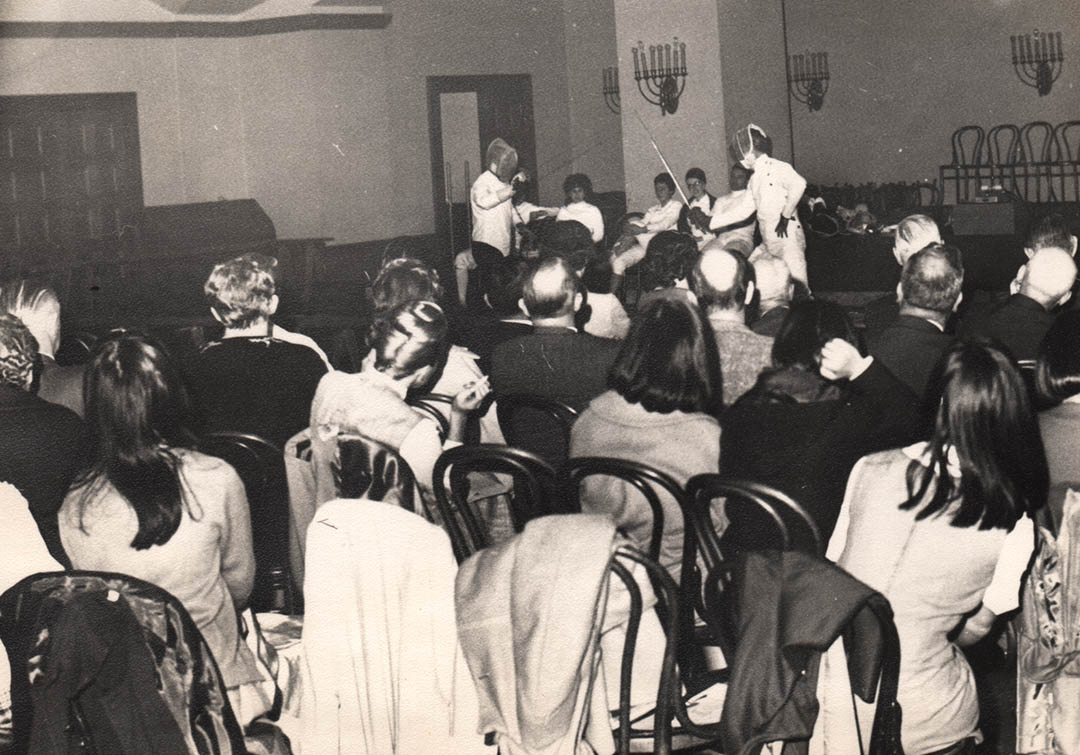
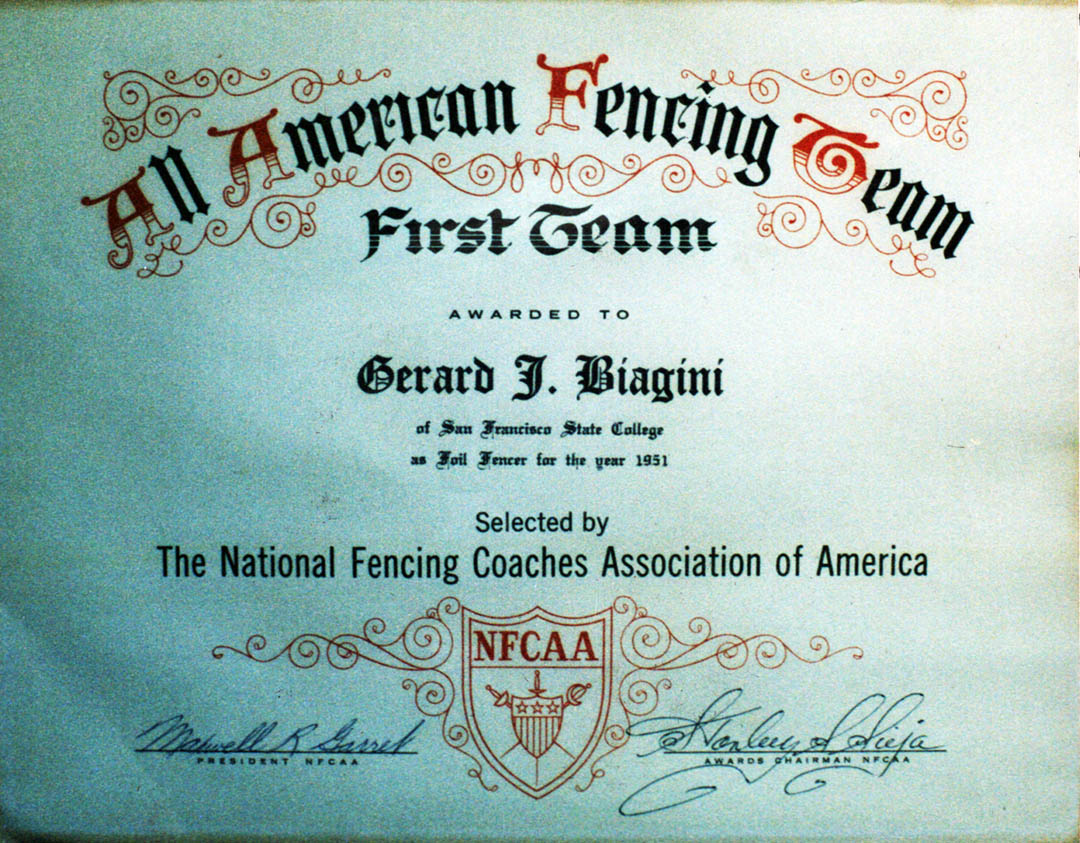

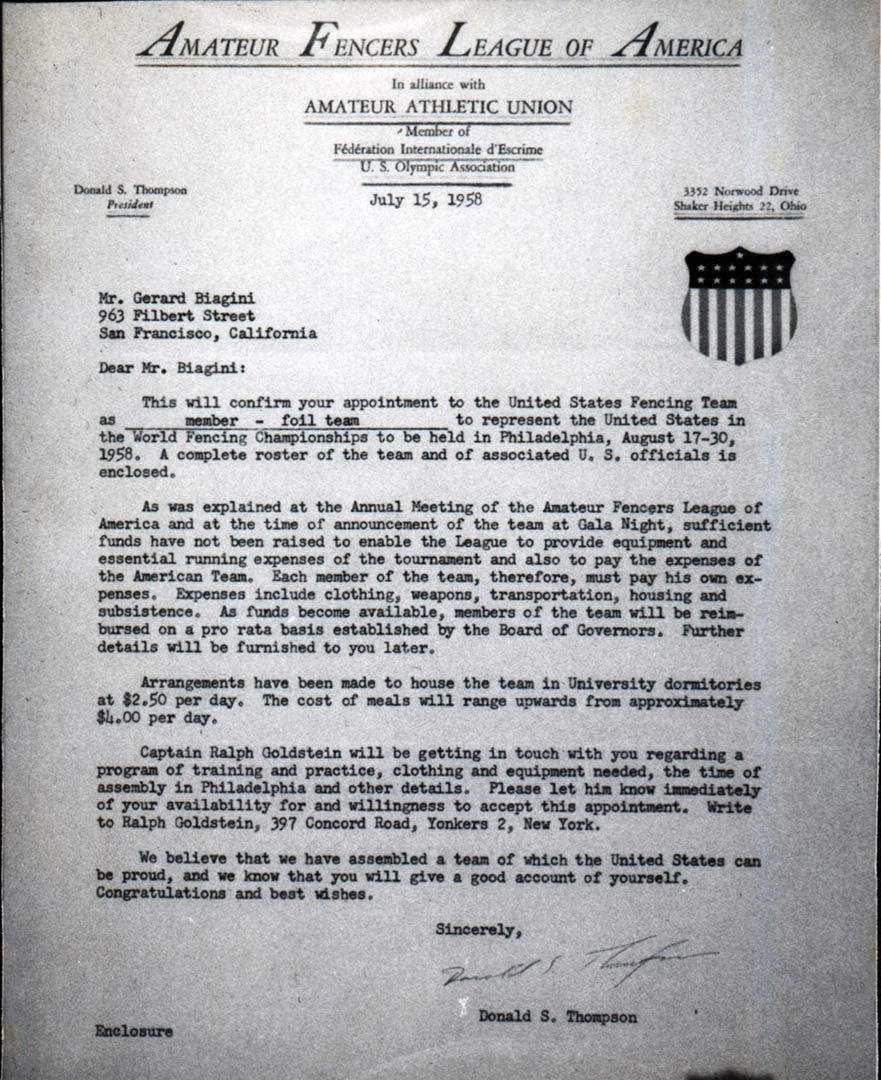
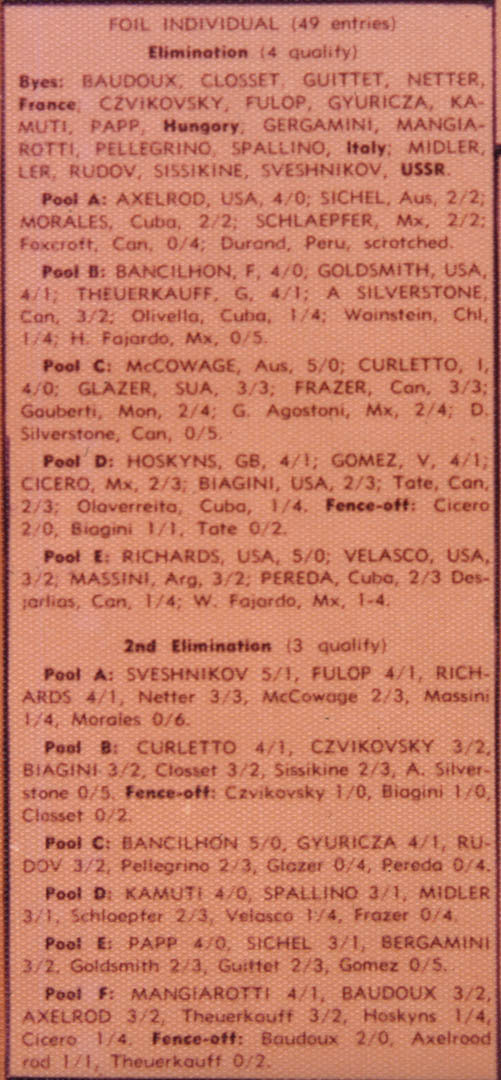

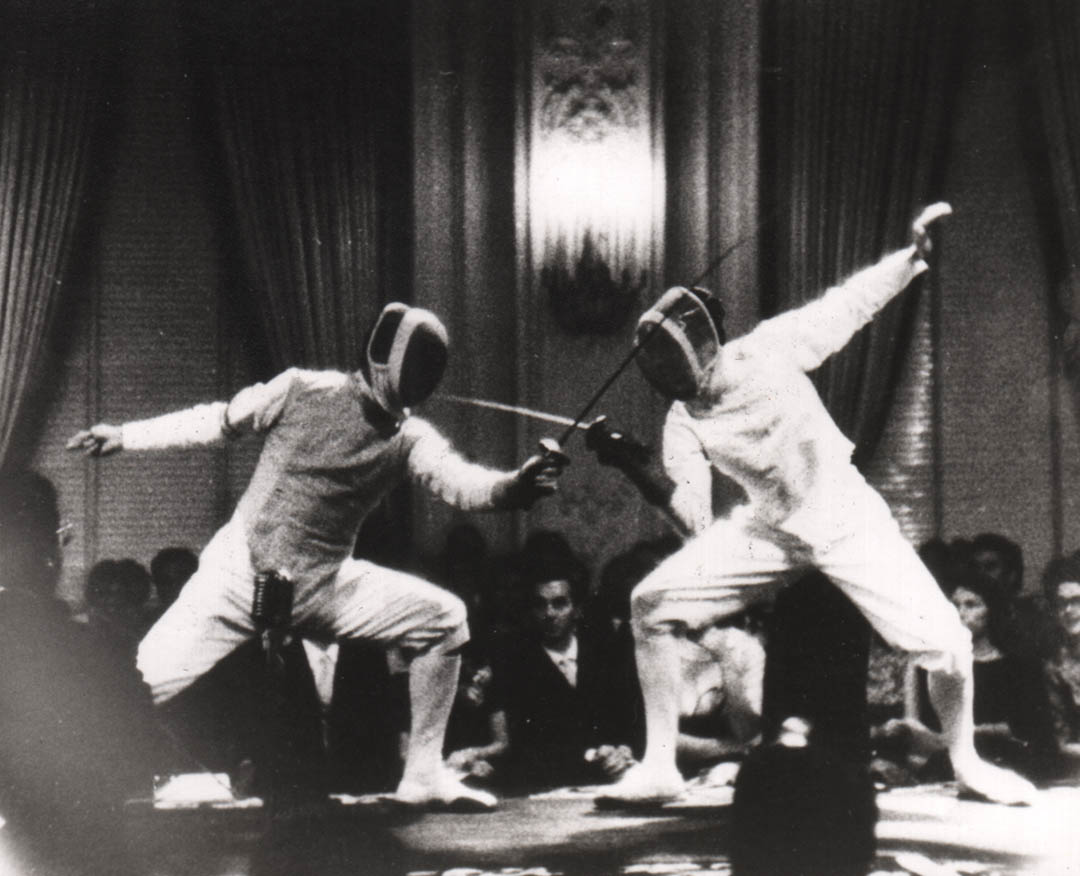
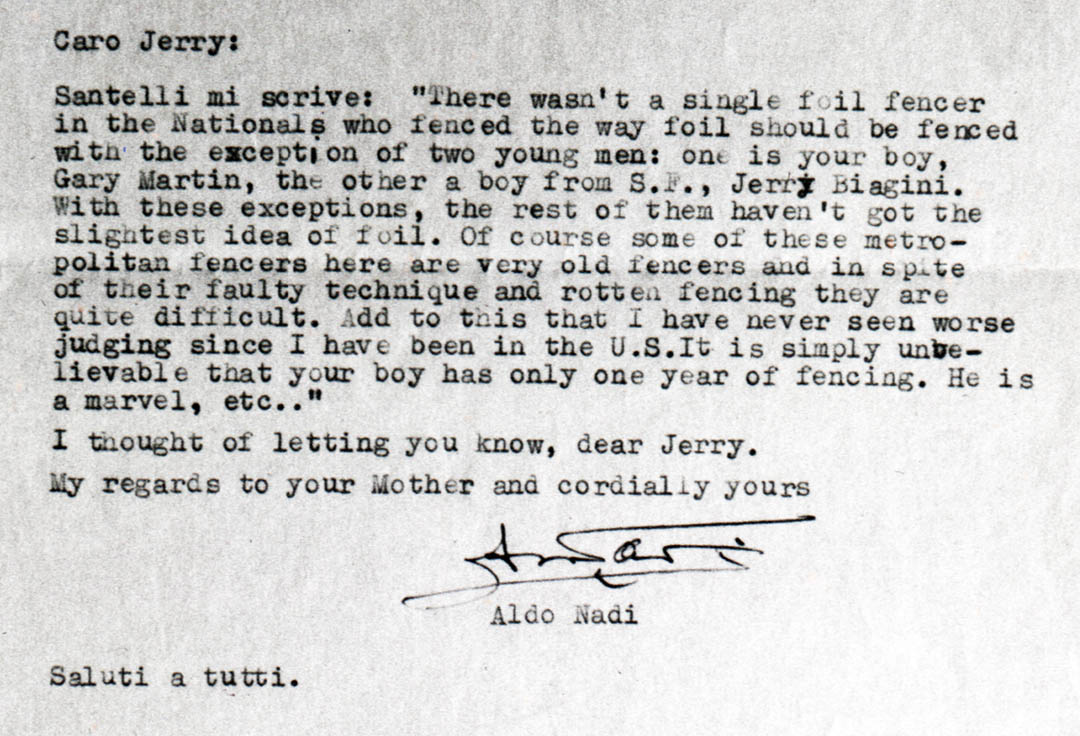
One correction on the above. Frenchman Claude Bancilhon also made it to the final without a bye in the first round.
Hi Gerry Do you remember my visit about 1949 I had been coaching in the Tampa bay area following the Olympics in Mexico city Anyway I am getting on also . 93 plus years .young ,I can still remember your friendship We did correspond a little but so long ago
Take Care Mike
Hello, Maestro O’Brien. Doug here. Mr. Biagini isn’t on computers at all, but I will be giving him a call this week and I will certainly relay your message. I won’t be visiting him for a bit until the coronavirus drops off, which can’t happen too soon for my taste, but I’ll give him a call. I love the photos on your website! All the best to you!
Dear Doug:
I am a student of Mr. Biagini and Maestro Marki. I studied under them while I attended City College of San Francisco from 1970 to 1972 before I transferred to Cal Poly SLO. I did fenced and coached the Cal Poly SLO team while I was there. I won the Pillar Memorial Championship one year as a student of Maestro Marki. I visited Mr. Biagini in January of 2019 and hope to see him again later this year! May be we can coordinate our visit next time. I am currently stuck in Hong Kong do to the COVID19 situation. Please let me have your contact information so I can reach out to you later.
Hi Raymond – feel free to contact me at: doug@westcoastfencingarchive.com